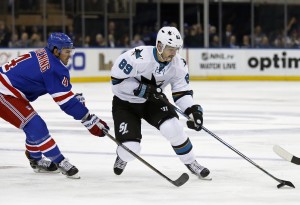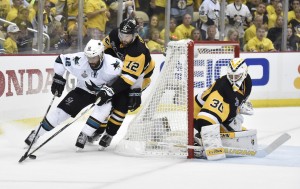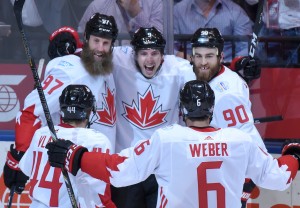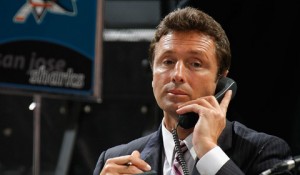Nearly a quarter of the way through the NHL 2016-17 season, and it’s clear the San Jose Sharks have missed out on reasonable expectations. With a record of 10-8-1 to this point, they are in decent shape in the standings, but they have also left a lot of opportunity behind.

The Sharks entered the season with an improved roster over the one which went to the Stanley Cup Final. Two additions, David Schlmeko and Mikkel Boedker, were distinct talent upgrades over the players who departed. The only area San Jose appeared weaker was the backup goalie, where a good goalie departed and an unknown skated in. With all the returning players and coaches, the Sharks had more ‘continuity’ than any team in the league.
Two Approaches
There were two ways San Jose could approach the start of the season. The first would be to push their top players with the sorts of minutes they played last season. The Sharks could use their continuity to “find their game” early. This would mean piling on points in the standings before other teams started to gel. A record of 15-5-0 is the sort of start one might expect with this path.

The second approach would place emphasis on developing younger players, including several playing at the American Hockey League level. The Sharks have considerable AHL talent, mostly on the forward lines. Allowing these players to get a shot at NHL ice time is a long-term investment intended to pay dividends later in the season. With this approach, the team could also dial back on the ice time for key players. The risk was simple. By foregoing continuity early on, the team might have less early success and lose some games they might otherwise win. A record of 10-10-0 is the sort of start one might expect with this path.
The Sharks chose the first path, aggressively using their top players. But the team failed to achieve a fast start. Instead, the record is closer to what one might expect from the path not chosen.
The Path Not Chosen

The path not chosen was likely the wiser path, even without the benefit of hindsight. The Sharks had a very long season in 2015-16, and therefore a very short offseason. This offseason ended even earlier for the one-third of the Sharks roster which participated in the World Cup of Hockey. With the oldest roster in the league, the ability to effectively navigate a second consecutive strenuous season is not a given. Additional challenges exist. San Jose is again among the teams with the most travel miles and will play a significantly increased number of back-to-back games (17). This is due to a compressed schedule (the schedule is compressed by the World Cup pushing a later season start plus a five-day mandated time-off for each team in midseason).
Travel miles, compressed schedules, an older roster, lots of back-to-backs and a shortened offseason were all strong signals to the team to make sure it did not get overworked early in the season.
Relative Impact
San Jose is not the only team dealing with at least some of these items. Other teams have taken notice. There is already speculation the compressed schedule is taking a toll. Tampa Bay Lightning general manager, Steve Yzerman, is very blunt on this subject. He openly questions whether player’s bodies are getting enough rest during their nearly year-round schedule.

Being the NHL’s oldest team with the shortest offseason to recover was an ‘up-front’ concern. Sharks general manager Doug Wilson and head coach Peter DeBoer mentioned this concern in the offseason and during the preseason. But whatever the plan was to mitigate the concerns, it hasn’t shown up.
For example, there is little difference in ice time for core players like Joe Pavelski and Joe Thornton. Both players are off to slower starts this season. Neither looks like the player who finished last season. In terms of relative impact, the Sharks are more vulnerable than most of the league’s teams.
Other older players worth keeping an eye on include Joel Ward, Paul Martin and Patrick Marleau. Goalie Martin Jones is younger than these players, but last season, he carried one of the largest workloads of any NHL goalie in the past decade. There is a correlation suggesting his heavy workload negatively impacted his game. Jones has started 90% of the Sharks games this season, up from 85% last season (playoffs included).
The Current Reality
The Sharks chose the continuity path to begin the season. It should have provided a distinct early season advantage over opponents, resulting in high percentage of victories early on. This did not occur. In the current standings, San Jose is a fringe playoff team, aided by the weakness of the Western Conference and Pacific Division.
All in all, the first part of the season has been less than successful for San Jose. They did not get off to a fast start. Nor did they provide NHL experience to their young, developing players. The Sharks are leaving the early portion of the season behind. The current five-game homestand can help this team advance towards mid-season form. They will need to get there soon. The challenges they face are larger than expected due to missed opportunities in the opening quarter of the season.
Zeke’s Notes
I’ve had my say when it comes to fighting in other articles, but I’ll reiterate it here in short form. It is something the league should discourage and hope to eliminate, but as of today, it still has a role and purpose.
But I’ll admit to being completely baffled by Sharks bruiser Micheal Haley, who for the second time this season, chose to fight on his opening shift. Absent an obvious and over-the-top triggering event fights two minutes into a game seem, well, stupid.
Haley’s most recent fight came on Saturday night against the Arizona Coyotes. Fighting, at the very least, should serve a purpose. Perhaps to change momentum in a game, perhaps to address another team’s tendency to play dirty or perhaps in return for an injury caused to a teammate. When Haley fought the Edmonton Oilers’ Darnell Nurse last season, I understood. Nurse had broken the nose of Sharks defenseman, Roman Polak when he jumped an unsuspecting Polak. There was a reason for that fight.
But this wasn’t the case in Arizona. Seeing two guys fighting before anyone’s even taken much of a hit is absurd. At the very least, the NHL should look into fights which serve no clear purpose and issue fines to the fighters. And perhaps fines to the teams as well.
In a prior note, I had mentioned the age of the Sharks’ top line when it featured Thornton, Ward and Pavelski, noting only five other NHL teams could even ice a line equaling or exceeding their combined age of 104. In the third period against Arizona on Saturday, Marleau lined up with Pavelski and Thornton, for a line with a combined age of 106. The line skated again in the next game against the New Jersey Devils on Monday. They have been effective together. As I suggested before, I don’t believe a line this old is sustainable with the minutes demanded of the Sharks’ top line. On the other hand, sometime in December the three players should reach a combined 3,000 career points. A combined 1,200 career goals should come later in the season.